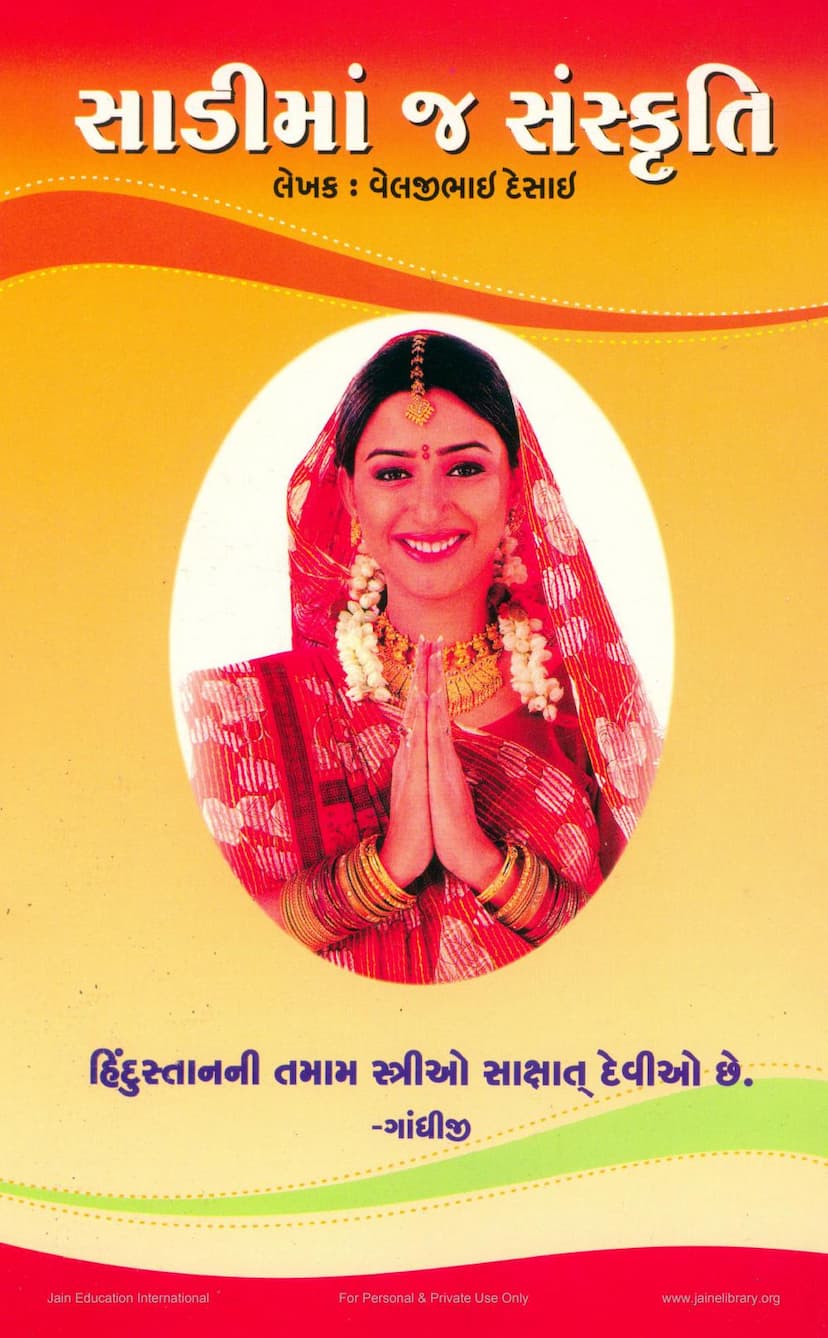Sadi Ma J Sanskruti
Added to library: September 2, 2025

Summary
This document is a comprehensive overview of the book "Sadi ma j Sanskruti" (Culture in the Saree) by Velji Desai. The author, Velji Desai, a mechanical engineer and an admirer of Mahatma Gandhi's philosophy, argues that the Indian saree is intrinsically linked to Indian culture and that its decline signifies a cultural erosion.
Here's a breakdown of the key themes and arguments presented in the text:
Core Argument: The Saree as the Embodiment of Indian Culture
- The Saree's Significance: The author posits that the saree is not just a garment but the very "soul" of Indian culture. It represents beauty, art, diversity, modesty, prosperity, divinity, spirituality, sanskaras (values), womanhood, restraint, chastity, purity, honor, respect, motherhood, sacrifice, penance, and dedication.
- Preservation of Womanhood: The saree is believed to accentuate womanhood, making it impossible for a woman in a saree to imitate men. It also provides a protective shield, ensuring respect and dignity.
- Cultural Decline with Saree's Disappearance: The author fears that the disappearance of the saree will lead to the destruction of Indian culture, creating a "stray cattle" like society that has lost its identity and soul.
Critique of Westernization and Modernization
- Gandhi's Views: The text frequently references Mahatma Gandhi's thoughts on industrialization, consumerism, and the dangers of blindly imitating Western culture. Gandhi's fear of industrialism becoming a curse, exploitation, and the potential for war arising from it is highlighted.
- Western Decadence: Europe is depicted as a materialistic and morally decadent society where family life is shattered, and traditional values are discarded.
- The "Madness" of Modernity: The author criticizes the modern trend of abandoning traditional attire like the saree in favor of Western clothing, viewing it as a form of collective "madness" that leads to the discarding of one's heritage.
- Critique of Education System: The education system is labeled as a "slaughterhouse of culture" that aims to turn women into artificial men, thereby destroying their inherent womanhood and contribution to society.
- Economic Exploitation: The author links the push for Westernization and industrialization to the economic exploitation of India by Western powers, emphasizing that following this path will only perpetuate poverty and slavery.
The Role of Women and Family Structure
- Women as Pillars of Culture: Women are seen as the preservers of Indian culture, embodying sacrifice and resilience.
- Dangers of Western Equality for Women: The author argues that the concept of Western "equality" for women, which encourages them to imitate men, is detrimental. This leads to the loss of womanhood, the breakdown of family structures, and unhappiness.
- The Ideal Indian Woman: The ideal Indian woman is portrayed as nurturing, sacrificing, humble, and devoted to her family, finding happiness in her traditional roles.
- Critique of Working Women: While acknowledging women's capabilities, the author expresses concern about women taking on jobs that lead them away from their domestic responsibilities and the adoption of masculine attire and attitudes. He believes this leads to a loss of their innate qualities and a less fulfilling life.
Specific Arguments and Examples
- Saree and Ahimsa (Non-violence): The graceful movement of a woman in a saree is believed to contribute to a non-violent and peaceful disposition in children who witness it.
- Personal Anecdote: The author shares a personal experience of his daughter-in-law abandoning the saree, leading to family discord, to illustrate the intensity of this cultural shift.
- Public Life: The saree is considered essential for women in public life to gain the trust and acceptance of the masses.
- "Madam" vs. "Sister": The author criticizes the aspiration of women to become "Madam" (a Westernized term) instead of embracing their role as "Sister" or "Mother," which he believes are more aligned with Indian values.
- Critique of Western Practices: The author provides observations from his travels in Europe, highlighting issues like declining marriage rates, single-parent households, gender role confusion, and emotional detachment, which he attributes to the abandonment of traditional values.
- Importance of Motherhood: The text emphasizes the unique role of mothers in nurturing and shaping society, suggesting that women should not compromise their maternal duties for external ambitions.
Call to Action
- Preserve the Saree: The author urges women, especially the younger generation, to embrace and preserve the saree.
- Reject Western Influence: He calls for a rejection of blind imitation of Western culture and a return to traditional Indian values and practices.
- Re-establish the Saree: The author suggests that educational institutions can play a crucial role in re-establishing the saree as a respected form of attire.
- Rural Empowerment: He advocates for strengthening rural economies and self-sufficiency through cottage industries, aligning with Gandhi's vision.
In essence, "Sadi ma j Sanskruti" is a passionate plea to preserve Indian culture by upholding the significance of the saree, which the author believes is a crucial symbol of national identity and traditional womanhood. The book serves as a cautionary tale against the perceived negative impacts of Westernization and a call to return to indigenous values and practices.